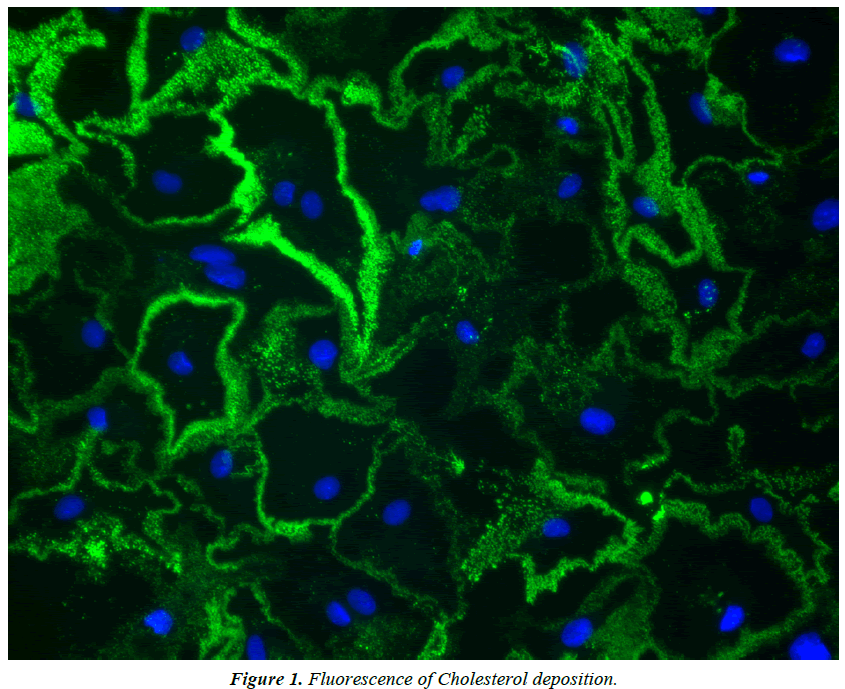Short Communication - Journal of Cholesterol and Heart Disease (2017) Volume 1, Issue 1
Cholesterol microdomain deposition by cholesterol-enriched macrophages.
Xueting Jin*
Laboratory of Experimental Atherosclerosis, Maryland, USA
- Corresponding Author:
- Xueting Jin
Laboratory of Experimental Atherosclerosis
Maryland, USA
Tel: (301)-496-4828
E-mail: tina.jin@nih.gov
Accepted on August 22, 2017
Citation: Jin X. Cholesterol microdomain deposition by cholesterol-enriched macrophages. J Cholest Heart Dis. 2017;1(1):18-19
Within atherosclerotic plaques, both intracellular and extracellular cholesterol accumulate. However, the origin and fate of extracellular cholesterol in atherosclerosis is far less understood compared with intracellular cholesterol. There are several reasons why accumulation of extracellular unesterified cholesterol is important to the development of atherosclerotic plaques: 1) unesterified cholesterol accumulates within the extracellular space of atherosclerotic lesions; 2) unesterified cholesterol is the form of cholesterol that cells typically excrete when eliminating excess cholesterol; 3) at high concentrations unesterified cholesterol can be cytotoxic; and 4) when not solubilized unesterified cholesterol forms crystals that can promote inflammation [1].
During cholesterol enrichment of macrophages with cholesterol, macrophages take up and store much of the cholesterol within lipid droplets. However, we have discovered that at the same time, the macrophages deposit unesterified cholesterol into the surrounding extracellular space [2-5]. We have detected these extracellular unesterified cholesterol deposits using a unique monoclonal antibody that detects cholesterol microdomains [6]. The human M-CSF differentiated monocyte-derived macrophages in this image were enriched with cholesterol by incubation for 1 day with acetylated low-density lipoprotein (Figure 1). The green color in this image indicates the extracellular deposition of cholesterol microdomains. The blue color shows macrophage nuclei. Characterization of these unique extracellular cholesterol microdomains is currently under investigation.
Similar extracellular unesterified cholesterol microdomains occur in human atherosclerotic plaques [4]. Thus, it will be important to learn how these extracellular deposits of cholesterol contribute to cholesterol trafficking within plaques and to the pathogenesis of atherosclerosis.
Acknowledgment
This work was supported by intramural funds from the National Heart, Lung, and Blood Institute (NHLBI), National Institutes of Health, USA.
References
- Jin X KH. Macrophage deposition of extracellular lipid particles with microdomains of ordered cholesterol arrays, in Handbook of Cholesterol: Biology, function and role in health and diseases, d.M.F. Watson RR, Editor. Wageningen Academic Publishers; 2016.
- Freeman SR,Jin X, Anzinger JJ, et al. ABCG1-mediated generation of extracellular cholesterol microdomains. J Lipid Res. 2014;55(1):115-27.
- Jin X, Freeman SR, Vaisman B.ABCA1 contributes to macrophage deposition of extracellular cholesterol. J Lipid Res. 2015;56(9):1720-6.
- Ong DS, Anzinger JJ, Leyva FJ. Extracellular cholesterol-rich microdomains generated by human macrophages and their potential function in reverse cholesterol transport. J Lipid Res. 2010;51(8): 2303-13.
- Jin X, Sviridov D, Liu Y, et al. ABCA1 (ATP-Binding Cassette Transporter A1) Mediates ApoA-I (Apolipoprotein A-I) and ApoA-I Mimetic Peptide Mobilization of Extracellular Cholesterol Microdomains Deposited by Macrophages. Arterioscler Thromb Vasc Biol. 2016;36(12): 2283-91.
- Addadi L, Geva M, Kruth HS. Structural information about organized cholesterol domains from specific antibody recognition. Biochim Biophys Acta. 2003;1610(2): 208-16.
